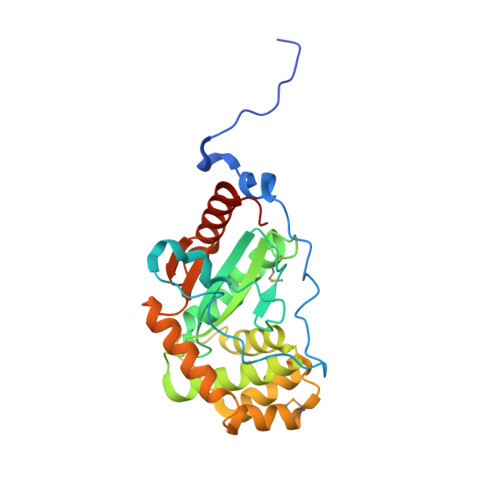A cryptic oxidoreductase safeguards oxidative protein folding in Corynebacterium diphtheriae.
Reardon-Robinson, M.E., Nguyen, M.T., Sanchez, B.C., Osipiuk, J., Ruckert, C., Chang, C., Chen, B., Nagvekar, R., Joachimiak, A., Tauch, A., Das, A., Ton-That, H.(2023) Proc Natl Acad Sci U S A 120: e2208675120-e2208675120
- PubMed: 36787356
- DOI: https://doi.org/10.1073/pnas.2208675120
- Primary Citation of Related Structures:
7UNN - PubMed Abstract:
In many gram-positive Actinobacteria, including Actinomyces oris and Corynebacterium matruchotii , the conserved thiol-disulfide oxidoreductase MdbA that catalyzes oxidative folding of exported proteins is essential for bacterial viability by an unidentified mechanism. Intriguingly, in Corynebacterium diphtheriae , the deletion of mdbA blocks cell growth only at 37 °C but not at 30 °C, suggesting the presence of alternative oxidoreductase enzyme(s). By isolating spontaneous thermotolerant revertants of the mdbA mutant at 37 °C, we obtained genetic suppressors, all mapped to a single T-to-G mutation within the promoter region of tsdA , causing its elevated expression. Strikingly, increased expression of tsdA -via suppressor mutations or a constitutive promoter-rescues the pilus assembly and toxin production defects of this mutant, hence compensating for the loss of mdbA . Structural, genetic, and biochemical analyses demonstrated TsdA is a membrane-tethered thiol-disulfide oxidoreductase with a conserved CxxC motif that can substitute for MdbA in mediating oxidative folding of pilin and toxin substrates. Together with our observation that tsdA expression is upregulated at nonpermissive temperature (40 °C) in wild-type cells, we posit that TsdA has evolved as a compensatory thiol-disulfide oxidoreductase that safeguards oxidative protein folding in C. diphtheriae against thermal stress.
Organizational Affiliation:
Department of Microbiology & Molecular Genetics, University of Texas McGovern Medical School, Houston, TX 77030.

















